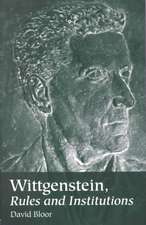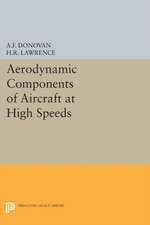The Enigma of the Aerofoil: Rival Theories in Aerodynamics, 1909-1930
Autor David Blooren Limba Engleză Paperback – 15 noi 2011
In The Enigma of the Aerofoil, David Bloor probes a neglected aspect of this important period in the history of aviation. Bloor draws upon papers by the participants—their restricted technical reports, meeting minutes, and personal correspondence, much of which has never before been published—and reveals the impact that the divergent mathematical traditions of Cambridge and Göttingen had on this great debate. Bloor also addresses why the British, even after discovering the failings of their own theory, remained resistant to the German circulation theory for more than a decade. The result is essential reading for anyone studying the history, philosophy, or sociology of science or technology—and for all those intrigued by flight.
Preț: 403.00 lei
Nou
Puncte Express: 605
Preț estimativ în valută:
77.12€ • 84.10$ • 65.02£
77.12€ • 84.10$ • 65.02£
Carte tipărită la comandă
Livrare economică 24 aprilie-08 mai
Preluare comenzi: 021 569.72.76
Specificații
ISBN-13: 9780226060958
ISBN-10: 0226060950
Pagini: 608
Ilustrații: 97 halftones
Dimensiuni: 152 x 229 x 33 mm
Greutate: 0.85 kg
Editura: University of Chicago Press
Colecția University of Chicago Press
ISBN-10: 0226060950
Pagini: 608
Ilustrații: 97 halftones
Dimensiuni: 152 x 229 x 33 mm
Greutate: 0.85 kg
Editura: University of Chicago Press
Colecția University of Chicago Press
Notă biografică
David Bloor is professor emeritus in the Science Studies Unit at the University of Edinburgh. He is the author of Knowledge and Social Imagery and coauthor of Scientific Knowledge: A Sociological Analysis, both published by the University of Chicago Press.
Cuprins
List of Illustrations
Acknowledgments
Introduction: The Question to Be Answered
Acknowledgments
Introduction: The Question to Be Answered
1 Mathematicians versus Practical Men: The Founding of the Advisory Committee for Aeronautics
2 The Air as an Ideal Fluid: Classical Hydrodynamics and the Foundations of Aerodynamics
3 Early British Work on Lift and Drag: Rayleigh Flow versus the Aerodynamics of Intuition
4 Lanchester’s Cyclic Theory of Lift and Its Early Reception
5 Two Traditions: Mathematical Physics and Technical Mechanics
6 Technische Mechanik in Action: Kutta’s Arc and the Joukowsky Wing
7 The Finite Wing: Ludwig Prandtl and the Göttingen School
8 “We Have Nothing to Learn from the Hun”: Realization Dawns
9 The Laws of Prandtl and the Laws of Nature
10 Pessimism, Positivism, and Relativism: Aerodynamic Knowledge in Context
2 The Air as an Ideal Fluid: Classical Hydrodynamics and the Foundations of Aerodynamics
3 Early British Work on Lift and Drag: Rayleigh Flow versus the Aerodynamics of Intuition
4 Lanchester’s Cyclic Theory of Lift and Its Early Reception
5 Two Traditions: Mathematical Physics and Technical Mechanics
6 Technische Mechanik in Action: Kutta’s Arc and the Joukowsky Wing
7 The Finite Wing: Ludwig Prandtl and the Göttingen School
8 “We Have Nothing to Learn from the Hun”: Realization Dawns
9 The Laws of Prandtl and the Laws of Nature
10 Pessimism, Positivism, and Relativism: Aerodynamic Knowledge in Context
Notes
Bibliography
Index
Bibliography
Index
Recenzii
“Valuable for everyone interested in the history of aeronautics, fluid dynamics, early aircraft, applied mathematics, and the sociology of science and engineering. Highly recommended.”
“A detailed technical history of the development of airfoil theory, a central achievement of modern aerodynamics . . . [as well as] a careful comparative analysis of the two main schools of aerodynamic theory in the early twentieth century, one British and the other German . . . . [Bloor] provides penetrating insights into different modes of reasoning involved in the application of mathematical theory to technological practice.”
"Superb. . . . Joins excellent recent work on the intriguing but technically demanding subject of the history of fluid dynamics by Olivier Darrigol and Michael Eckert, and opens the field to historical-sociological analysis. Bloor’s extensive case study compares the development of aerodynamical theories of lift in Britain and Germany from 1909 to 1930. . . . One of the most convincing cases since Leviathan and the Air Pump for the simultaneously cognitive and social character of knowledge production."
“The reader is expertly led on a narrative journey that is filled with technical detail on the accomplishments of a bygone era.”
“Historians and philosophers rethinking the underpinnings of myriad scientific projects through the lens of technoscience would do well to grapple with Bloor’s magnum opus. It rewards the patient reader with a partial and situated toolkit to face the evolvingdesigns of a nature we help make.”
“David Bloor’s The Enigma of the Aerofoil sets out to explain the development of aerodynamics in Britain and Germany early in the twentieth century. Why, he asks, was it in Germany, and not in Britain, that practitioners produced a fusion of theory with aerofoil design when the basic concept upon which the Germans relied, that of circulation about an aerofoil with the flow treated otherwise as an ideal fluid, had long before been used by Rayleigh in Britain for the flight of a tennis ball? Bloor probes this ‘enigma,’ combining deft analysis of the technical arguments involved with a sure examination of the social frameworks within which his several protagonists worked. Along the way, he grapples with the character of reasoning and practice when scientific theory confronts engineering reality. Written by a founder of the strong program in the sociology of science, Bloor’s Enigma is among the very finest histories that raise these difficult and important questions—one that succeeds by refusing to break the intellectual from the social, and both from the exigencies of engineering practice.”
“In The Enigma of the Aerofoil, David Bloor paints a seamless picture of how and why British and German theorists struggled, typically in different ways, to make an aerodynamic theory that corresponded even approximately with aeronautical practice. In doing so, Bloor gives us a stark reminder of the extraordinary power—and the limits—of mathematics and mathematicians in their many guises. As a result this book will help redefine what we take the central sciences and technologies of the twentieth century to be, and how we study them.”
“A masterpiece of writing and research. David Bloor brings his varied background to the table, writing the only book that describes a wonderful mixture of the scientific, historical, philosophical, and sociological forces that help to explain the ‘enigma’ of the aerofoil.”















